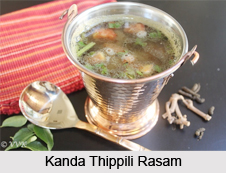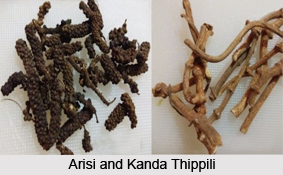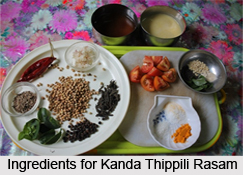 Kandan Thippili Rasam is a herbal rasam traditionally prepared in Karnataka to relieve one from numerous health issues. South Indians prepare varieties of Rasams. Chief ingredients are dal, Rasam powder, turmeric powder and tamarind. Kanda Thippili is an Indian herb to make this Rasam. Although Thippili is medicinal, the rasam does not taste like medicine. Thippili has a unique flavour and aroma that makes the rasam tasty and unique.
Kandan Thippili Rasam is a herbal rasam traditionally prepared in Karnataka to relieve one from numerous health issues. South Indians prepare varieties of Rasams. Chief ingredients are dal, Rasam powder, turmeric powder and tamarind. Kanda Thippili is an Indian herb to make this Rasam. Although Thippili is medicinal, the rasam does not taste like medicine. Thippili has a unique flavour and aroma that makes the rasam tasty and unique.
"Thippili" is a rare flowering vine called "Long Pepper". The root of this plant is called "Kanda Thippili" and the dried fruit of the plant is called "Arisi Thippili". It looks like small stick. This plant is known for its medicinal properties and is used commonly in Ayurvedic medicine. This herb is believed to be medicine for cough and common cold and also stimulating digestion. Women during post-natal period gather flab and this herb is used and is believed to dissolve the unwanted flab and firm up. This is also beneficial for de-stresser in body pains without the side effects of modern medicines. It is particularly useful for knee and back pain.
Ingredients for Kanda Thippili Rasam:

•Toor Dal - 2 tsp
•Coriander seeds - 3 tsp
•Black Pepper - 2 tsp
•Cumin Seeds - 1 tsp
•Dry Red Chilli - 5
•Dry Coconut - 4 tsp
•Kanda Thippili - 4 tsp
•Arisi Thippili - 2 tsp
•Tamarind Pulp - 1/2 tsp
•Asafoetida - 1/2 tsp
•Turmeric Powder - 1/4 tsp
•Ghee - 4 tsp
•Jaggery - 1/2 tsp
•Salt to taste
•Mustard Seeds - 1/4 tsp
•Curry Leaves - 8 to 10
•Tomato - 2
•Garlic (optional)
•Water - 5 cups 
Method:
1. Boil tomatoes in 2 cups of water.
2. Add tamarind, turmeric, salt, asafoetida to it and let it boil for 10 minutes.
3. In a pan heat 2 tsp ghee, fry toor dal, coriander seeds, black pepper, cumin seeds, dry red chilli, arisi thippili and kanda thippili till it turns light brown.
4. Let it cool down and grind it with coconut into a powder and add to the boiling contents.
5. Add little jaggery to balance salt, tamarind and chilli.
6. Add 3 more cups of water and boil on low-medium heat until the rasam is frothy and bubbly.
7. Turn off when the content froths up. Remove from heat. Do not over boil rasam.
8. Heat some ghee.
9. When hot, add mustard seeds and wait for them to pop.
10. Add curry leaves and hing.
11. Add this is the rasam and mix well before serving.
12. Serve Kanda Thippili Rasam along with hot, steamed rice and a side of vegetables for a healthy and simple meal.
Related Articles
History of Indian Food
Food in Ancient India
Food in Vedic Period
Recipes in Vedic Period
Indian Food
Indian Herbs




















